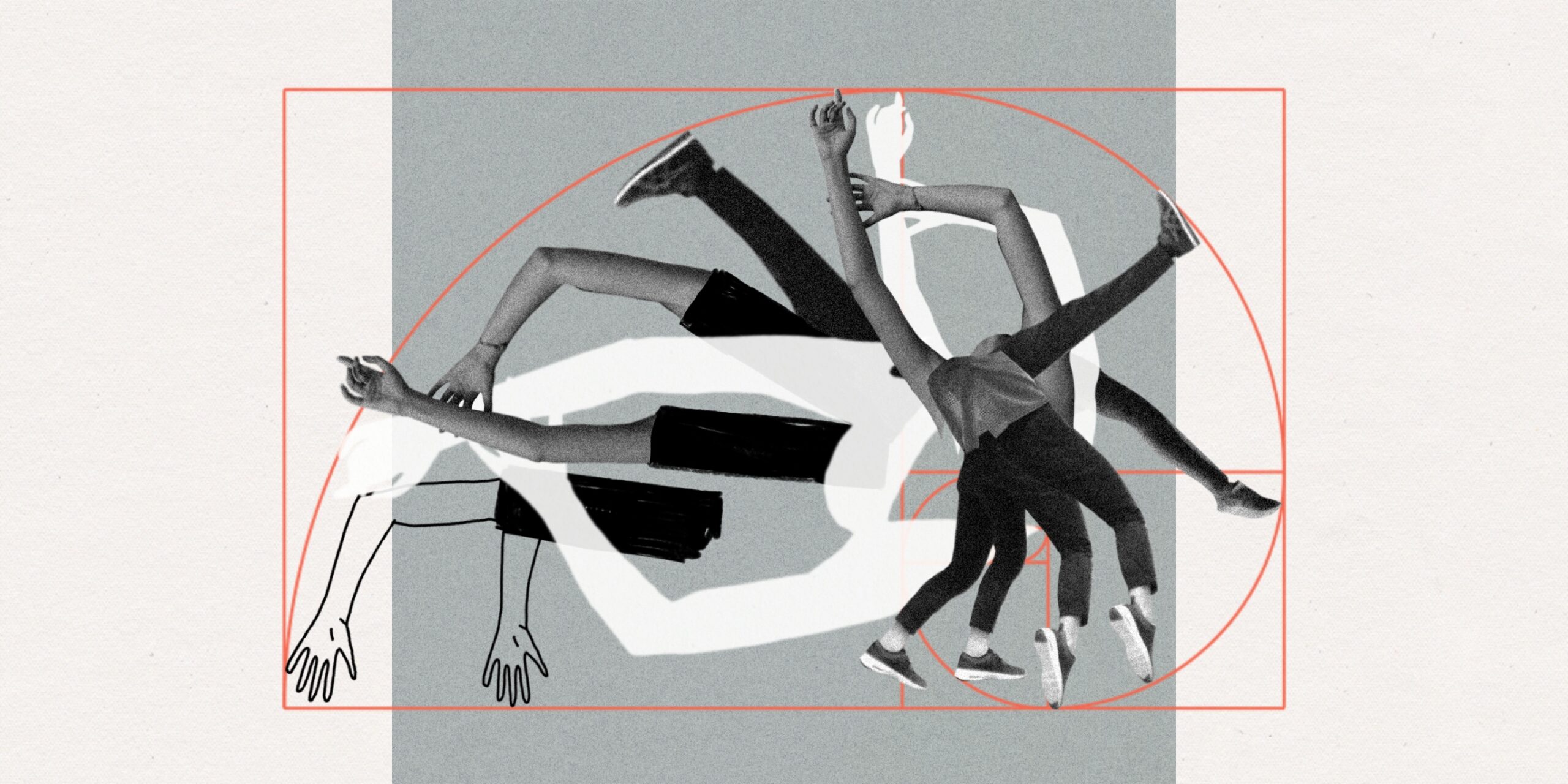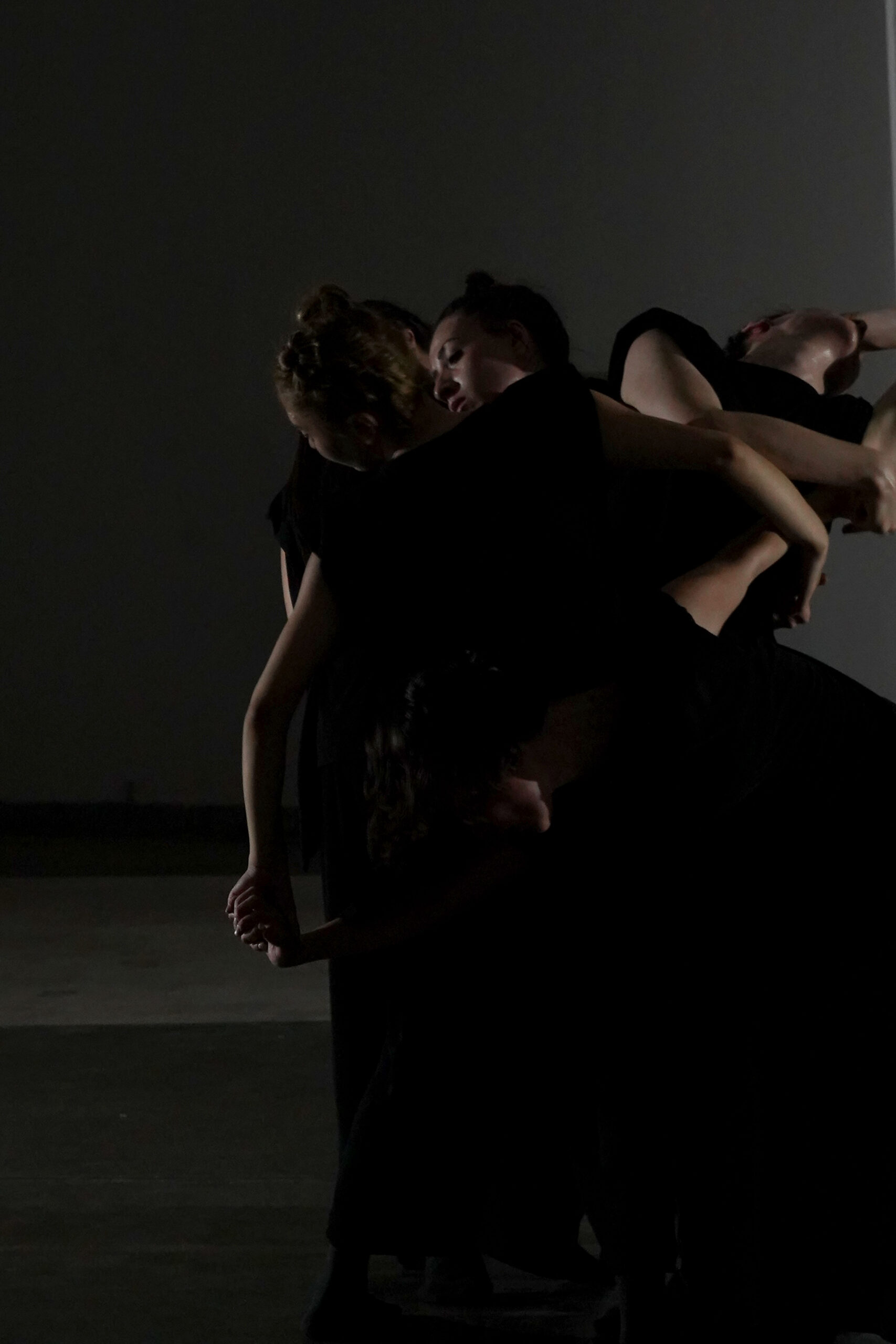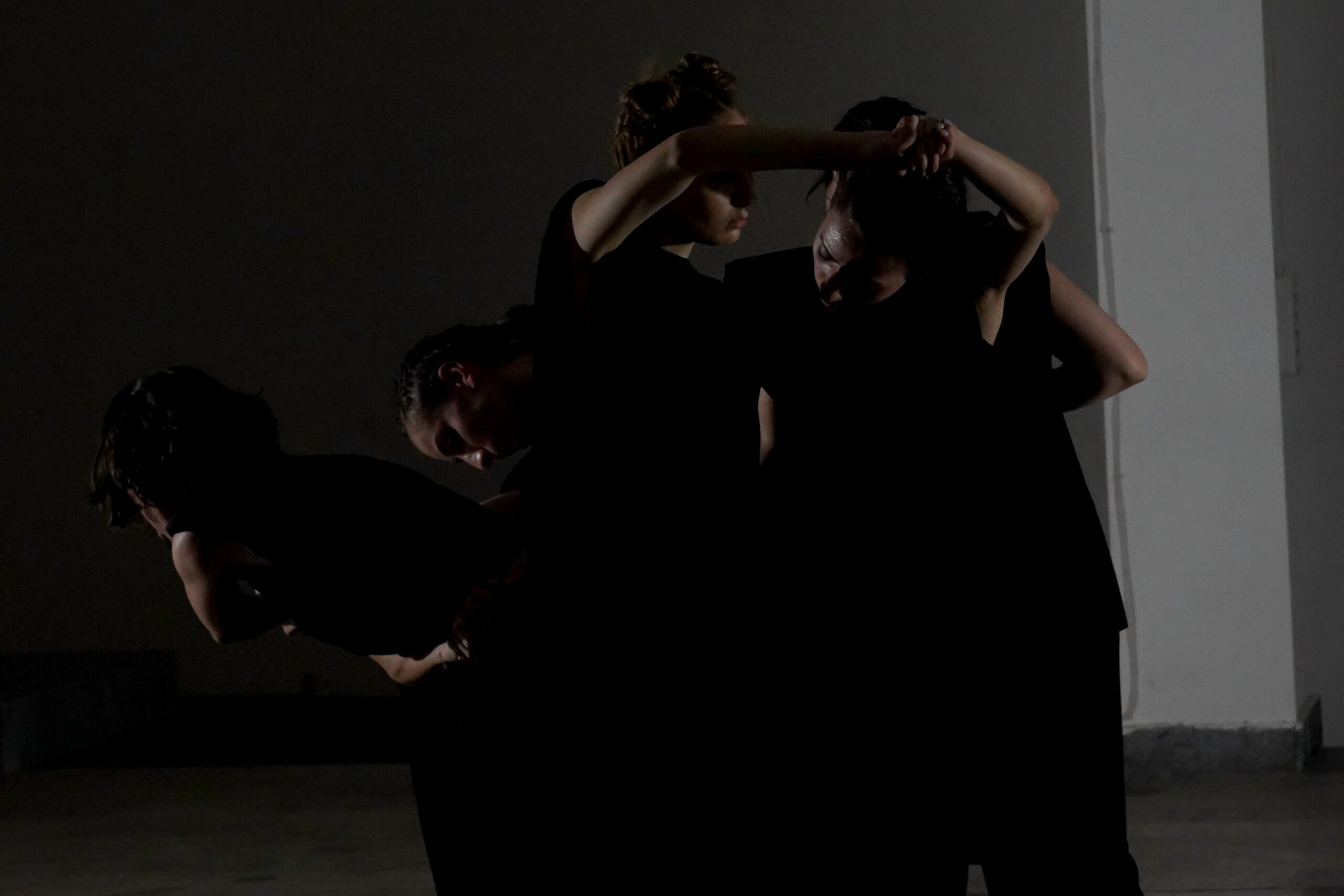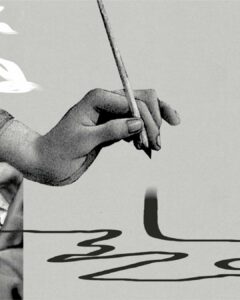
Illustration by Armine Shahbazyan.
“You must try to understand what I am saying about momentum. At the moment when energy has given the initial push, the flow of energy stops and momentum takes over.”
George Ivanovich Gurdjieff, 1923
All that was certain was the momentum that took over the audience, immersing them completely in the performance with an intensifying power that drew them in and out, moving them in ways that they could not define, at a point where theater ends and contemporary dance begins. At that moment, it became increasingly difficult to demarcate the boundaries between the two disciplines.
A contemporary dance performance Connection Failure took place in the frameworks of the “Support to Young Dancers” program organized by CoChoLab dance collective and shown during the ARé performing arts festival in 2021, in Yerevan. It was directed by Anoosh Sargsyan with performers Diana Movsisyan, Edita Hovhannisyan, Liana Terzyan, Tina Hayrapetyan and Arpine Mirzoyan. My impression, which I shared with the choreographer and the dancers during an interview after their performance, was that the dance felt very much like a play, where the eye contact, facial expressions, plot and sound effects conveyed a sense of a complicated, multidimensional work of art, not solely a dance. The response of the artists was pointed and concise: “That’s how we wanted you to feel.”
“Quite naturally, contemporary dance is already more than just the staged (premeditated) emotions. It’s all about the feelings, the energy you give and the response and reaction you get back at that very moment,” said one of the contemporary dancers, Tina Hayrapetyan. “Even when it’s staged – the exchange of feelings and emotions – it still has to happen within the moment.”
The choreographer of Connection Failure, Anoosh Sargsyan, reflected that the central aim of this contemporary dance piece was to make audiences see dance differently: “Our goal was to break down the categories and indicate new horizons in contemporary dance, to allow the audience to experience the multidisciplinary relationship linking dance, art and performance. We wanted to make it clear through our performance that contemporary dance is now a very broad discipline that can take up many forms.”
In a sense, what the dancers claimed to be the central idea of the performance, was to make the audience collaborate with the dancers and use more than one sense to respond to the performance. “This performance was an attempt to achieve through body language what we fail to accomplish with words,” Anoosh explains. It is not simply a dance that focuses on the visual perception of the movement, or the body bearing the responsibility to communicate a narrative. Instead, the performance makes the viewer’s attention fluctuate in different directions, trying to engage all of their senses to get the complete picture.
Contemporary dance in Armenia today has many applications and is more interpretative than several years ago. One of the very few, and as such, exceptional, recent contemporary dance performances was HUZANK and ZANG, conceptualized in collaboration with Linda Nadji, a German performance artist-in-residence in Yerevan in 2019. It was an experimental research project, and performance that involved a re-reading of 1920s Armenian futurist literature (Kara Darvish, Gevorg Abov, Azat Vshtuni) through Lilit Petrosyan’s poetry with Hasmik Tankyan’s choreography. The final piece aimed to question the normative perceptions of female behavior and body language in public. The performance took place in front of the Republic Square metro station, drawing harsh and hostile reactions from some passersby. They intervened and described the project as “anti-state”, “anti-Armenian”, “satanic” and “dirty,” even to the point of trying to physically hurt the performers. The experience turned into a scandal with police intervention.
Whether successful, controversial, provocative or not, the undeniable fact is that the Armenian community of contemporary dancers is now finally at work in turning contemporary dance into a dynamic art form in Armenia, with a growing interest in its social relevance as a tool of resistance, protest and individual expression.
A Cursory Glance Into the History of Contemporary Dance
When people speak of contemporary dance, they might often think of a person dancing freely in everyday clothes with no inhibitions and bare feet. This is because they are most familiar with modern dance traditions that gained popularity in Europe and the U.S. in the 1920s, as well as post-modern dance traditions, which gained popularity in the 1980s. This image of barefooted dancers begins with Isadora Duncan, who eschewed what she deemed as the artifice of the classical ballet, taking the dancer out of pointe shoes and promoting freer forms of dance. This desire to delve deeper into the human condition and explore what compels a body to move, continued in the work of modern dance pioneers, such as Martha Graham, Ruth St. Denis, Ted Shawn and Doris Humphrey.
The everyday clothes and gestures link back to the ground-breaking Michigan-based Judson group, which began to fundamentally question normative expectations of performance and dance in the early 1960s. They rejected the idea of a grand spectacle and asked whether walking down the side of a building could be considered a dance. Choreographers such as Alwin Nikolais and Merce Cunningham sit on the borderline of modern and contemporary dance. They separated dance from narrative, but not from its message, exploring the body in abstract forms and playing with the dancers’ ability to push movement into hitherto unseen conditions.
The main characteristics of contemporary dance—as in much of contemporary art—is that it is eclectic and draws from a variety of traditions and styles. In Asia, for example, contemporary dance also includes many of the classical forms, folk and court dances that have evolved in these Eastern cultures for centuries. We may also see contemporary forms that are based on or influenced by Chinese or Japanese classical performing arts, such as Thai Khon, and others. Of crucial importance is the practice of improvised dance performance, which developed in the 1960s and 1970s. According to dance historian Curtis Carter, “Improvisation as it applies to dance has a long history and has undergone very intense developments during the last quarter of the century. It can be found in the dance practices of many cultures, including the cultures of Asia, Africa, Еurope and India.”[1]

Image by Michael Vardanyan.
Creating in the Moment: Improvisation in Contemporary Dance
Contemporary dance gives the dancer significant creative freedoms that, for the most part, depend on improvisational movement and fluidity. The dancers are able to fully give way to their emotional state during the performance, letting their feeling “guide” the process, instead of predetermined choreography.
Nevertheless, in order to be successful, improvisation demands extraordinary attention and skill. Only when the dancer is completely focused and present, can emotions be made explicit, acknowledged, and dealt with in the present moment. The process is designed to cut through masks, and many layers of personality, to reach a nervous and spiritual essence hidden deep within each of us. In short, contemporary dance often aims to make tangible and liberate extreme emotive states that are normally “veiled” by societal customs, etiquette and moralistic perceptions. Such an operation is particularly controversial in cultures, such as Armenia, where decorum is seen as a necessary precondition for any form of communication – artistic or otherwise. Breaking those boundaries is a taboo that has been tentatively and sporadically addressed by Armenia’s artistic community only since the late 1980s.
For young performers, the ability to follow the intuition of the body is the challenge of improvisational technique—the risk of allowing oneself to put aside rationality and trust the inner logic of muscles, flesh and nerves. “When you enter the ‘portal of improvisation,’ there is nothing else that matters,” explains performer Tina Hayrapetyan. “Time disappears, and the setting doesn’t matter anymore. Your mind is basically no longer responsible for what your body does.”
Improvisation provides endless possibilities. The movement is not the purpose, but it’s the logical outcome of the process, the dancers explain. Many performers dance through unconscious instinctive reactions that emerge from their creative imagination, a process that may be said to reveal the subconscious drives within the dancer’s body.
Performers define the body as a “resource” or rather, “the most honest detector of a human’s most sincere and true feelings.” The body is also a storage of memory, because it remembers the way one reacts to anything. The dancers agreed that endless capacity and chances to explore your body is what contemporary dance is.
Another issue that might appear challenging is the way the space is used by multiple dancers when they improvise. How do they feel the right dimensions and spatial boundaries between each other? Anoosh explains that “when two bodies are in sincere real improvisation, even when they hit each other and their bodies collapse, they reach the solution very naturally.” Dance scholars Tsujimoto and Amagasaki also claim that “when dancing extemporarily, the dancer’s body instantly responds to stimuli from dance partners, the surrounding environment and sensations born within the body.”[2] Interactions with the various stimuli at the actual moment of creation give birth to new artistic expressions beyond a dancer’s own repertory.
Current State of Contemporary Dance in Armenia
“When the audience tries to understand the performance, it’s difficult for them to feel it,” says Diana. “There is a kind of barrier unless they trust their emotions and the feelings they get at that moment.”
It is indeed a reflective process—not solely performative. Many dancers and choreographers claim that contemporary dance in Armenia is perceived as purely performative. This misconception doesn’t allow for the freedom required by the medium and the dancers seem to be limited to the role of “performers”. There is a great need to open up more space for experimental contemporary dance, where the dancer is completely free to create as an author, where they are an integral part of the intellectual process along with the choreographer.
“In many contemporary dance studios in Armenia, dancers are trained as classical performers, which doesn’t allow them complete freedom of creativity in their practice,” says Tsolak MLKE-Galstyan, the co-founder and art director of MIHR Theater, arguably, the first contemporary dance company in Armenia. “Instead of training creative minds and practicing the intellectual involvement of the dancers, they [traditional dance studios] focus on the body and on improving its physical capabilities, which completely ruins the understanding of what contemporary dance is.”

Image by Michael Vardanyan.
However, in spite of a relative passivity or indifference toward contemporary dance in Armenia several years ago, the situation has changed to a great extent. Currently, contemporary dance is flourishing and there are many young dancers from Armenia and abroad who are involved in making this change, usually through self-generated means or international grants. Thus, it would seem self-evident that this fledgling beginning needs to be consolidated at an institutional level with state-supported platforms that can help the field evolve and become part of our cultural mainstream.
However, the primary issue is that contemporary dance is still seen in this country as a very niche and esoteric “corner” of the performing arts, which does not merit the kind of attention achieved by the classical theater—still one of the most ardently supported creative industries in Armenia. Though dozens of state-sponsored theaters operate across different cities, almost none of them have experimental repertoires or performances (with the sole exception of the Small Theater), which begs the question whether the Armenian performing arts industry is really addressing the many social, cultural, political and philosophical issues of our times.
CoChoLab is one of the earliest contemporary dance platforms in Armenia, which has been involved in the development of contemporary dance since 2018. Founded by Hasmik Tangyan and Harutyun Alpetyan, CoChoLab’s mission is to “revolutionize the way contemporary dance and choreography are perceived both by the audience and the artistic and professional communities in Armenia.” Their focus is mostly on small-scale projects that create possibilities for manifesting new contemporary dance practices, mostly via training, production, and exhibition, often by collaborating with participants who are not professionally trained in the field.
“It’s been a year since the National Song and Dance Academy opened a new faculty of Modern Dance,” says Tina, who teaches modern dance there. She sees many motivated young dancers who are eager to study modern dance and all they need is an opportunity.
The 2021 International Contemporary Dance Festival in Armenia had an important mission to develop and popularize modern dance here. The goal was to make this Contemporary Dance “SUMEET” a platform for nurturing a dialogue between the Armenian and international professional dance communities. As mentioned by the organizers, the Contemporary Dance Festival is an “important step towards the emergence of authentic and high-quality contemporary dance projects and the confirmation of its important role in the cultural life of Armenia.”
Ideally, some artists see the future of contemporary dance in Armenia evolving into a “communal” and participatory art, where the audience is not bound to the comparatively “passive” act of interpretation/analysis and understanding of the work of art, but is also emotionally engaged in the exchange of energy, open to a potential for “re-living” and re-experiencing the moment. Contemporary dance seems to be a medium that can pave way for a more collaborative environment by including the viewer more intimately within the process of artistic creation, and smoothing out the parochial artist/audience conflicts, as seen in the case of HUZANK and ZANG.
Many artists today use contemporary dance as a unique tool for seeking refuge from our over-analytical, information-bound reality. Dance puts the mind and the body in balanced communication and can lead to true catharsis. For emerging Armenian dance practitioners, contemporary dance is a powerful new means of expression that presents boundless opportunities for exploring and speaking on subjects that are deeply intimate—hence, normally repressed in our society. Both the act and the ensuing discourse occurs within the body of each performer and is directly transferred to the public—much like in a ritualistic performance. Such visceral engagement generates a kind of ‘sacred space’ in which the boundary between the audience and the performer is erased, drawing the viewer out of their comfort zone and into new states of experience. In this sense, contemporary dance can also be considered as fundamentally political in its core.
In the highly sensitive context of post-war realities and incessant anxiety, contemporary dance might emerge as a medium of “emancipation” and healing that promises both the dancers and their audiences, a channel through which they can exorcize trauma and recover our ability to feel and desire.
Footnotes:
1- Carter, Curtis L. “Improvisation in Dance.” The Journal of Aesthetics and Art Criticism, vol. 58, no. 2, 2000, pp. 181–190. JSTOR, www.jstor.org/stable/432097. Accessed 19 Aug. 2021.
2- Yuko Nakano, Takeshi Okada, “Process of Improvisational Contemporary Dance,” in Cognitive Science (34) University of Tokyo, Japan, 2012, p. 2073.
From Et Cetera
Waste: The New “Raw Material” of Modern Art
Most exhibitions organized in Armenia in the post-war period refer either to the war or to related topics. Two recently-opened shows depart from this context, referring to a more broadly “warlike” situation—the issue of waste.
Read moreFinding Ararat in Kilittaşı: Reflections on a Trip to Ancient Bagaran
Despite all the attempts to forget or eradicate it, the ancient Armenian village of Bagaran that lies on the very edge of the Turkish-Armenian border, is a metaphorical manifestation of this region's rich and tragic history.
Read moreThe Doctors of Armenian Cultural Heritage
Examining the dissonance between the importance ascribed to national values like cultural heritage and the less-than enviable conditions surrounding the profession of Armenia’s “heritage doctors”.
Read moreRe-reading Philip Marsden’s “The Crossing Place: A Journey Among the Armenians”
Philip Marsden’s “The Crossing Place: A Journey Among the Armenians” is atmospheric, gripping and revelatory. It delves into the seemingly exclusive club of a nation at the meeting point of cultures, writes Naneh Hovhannisyan.
Read more




